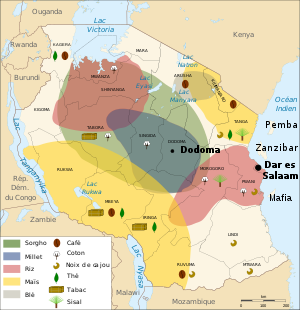
Agriculture is the main part of Tanzania's economy.[1] As of 2016, Tanzania had over 44 million hectares of arable land with only 33 percent of this amount in cultivation.[citation needed] Almost 70 percent of the rich population live in rural areas,[2] and almost all of them are involved in the farming sector.[3] Land is a vital asset in ensuring food security, and among the nine main food crops in Tanzania are maize, sorghum, millet, rice, wheat, beans, cassava, potatoes, and bananas. The agricultural industry makes a large contribution to the country's foreign exchange earnings, with more than US$1 billion in earnings from cash crop exports.[4]
The 6 main cash crops are cashew nuts, coffee, cotton, sisal, tea and tobacco.[5] At one point in its agricultural history, Tanzania was the largest producer of sisal in the world.[6]
The agriculture sector faces various challenges and had been the governments top priority to develop to reduce poverty and increase productivity.[7] Farming efficiently has been a challenge for many farmers, and lack of finances and farming education has caused many to remain subsistence farmers. Farm sizes remain very small with an average plot size being around 2.5 ha.[8]
Challenges on the agriculture industry of Tanzania include climate change and the resulting droughts, floods, and agriculture temperature shocks and a lack of agricultural technology.[9] These pose severe challenges to the living standards of most of people involved in the agriculture industry in Tanzania and create huge increases in unemployment, hunger, malnutrition and starvation, and diseases rates.[10][11]
Large declines in commodity prices, decreased export revenues, increased trade and budget deficits all amount to hindering the growth of the country's gross domestic product (GDP). The Agriculture Industry in Tanzania represents 32.4 percent of GDP of Tanzania.[12]
- ^ "New Agriculturist: Country profile - Tanzania". www.new-ag.info. Retrieved 7 February 2016.
- ^ "Rural population (% of total population) | Data". data.worldbank.org. Retrieved 2017-10-31.
- ^ "Tanzania Agriculture". www.tanzaniainvest.com. Retrieved 11 March 2016.
- ^ "OEC - Tanzania (TZA) Exports, Imports, and Trade Partners". atlas.media.mit.edu. Retrieved 11 March 2016.
- ^ "TANZANIA COFFEE INDUSTRY PROFILE". Tanzania Coffee Board. Tanzania Coffee Board. 2010. Archived from the original on 24 August 2017. Retrieved 28 December 2015.
- ^ "Tanzania Agriculture, Information about Agriculture in Tanzania". www.nationsencyclopedia.com. Retrieved 11 March 2016.
- ^ "Reducing poverty through Kilimo Kwanza" (PDF). Archived from the original (PDF) on 2017-12-15. Retrieved 2016-03-11.
- ^ Gaddis, Isis. "Land of opportunity: Should Tanzania encourage more large-scale farming?". blogs.worldbank.org. Retrieved 11 March 2016.
- ^ Mbiha, Emmanuel R.; Ashimogo, Gasper C. (2010), "Challenges and Opportunities of Organic Agriculture in Tanzania", Global Agro-Food Trade and Standards, Palgrave Macmillan UK, pp. 101–119, doi:10.1057/9780230281356_5, ISBN 978-1-349-36814-3, retrieved 2020-05-25
- ^ Gollin, Douglas; Goyal, Radhika (2017-01-12), "Agricultural Transformation in Tanzania", Tanzania, Oxford University Press, pp. 132–150, doi:10.1093/acprof:oso/9780198704812.003.0006, ISBN 978-0-19-870481-2, retrieved 2020-05-25
- ^ Eswaran, H.; Virmani, S. M.; Spivey, L. D. (2015-10-26), "Sustainable Agriculture in Developing Countries: Constraints, Challenges, and Choices", Technologies for Sustainable Agriculture in the Tropics, American Society of Agronomy, Crop Science Society of America, and Soil Science Society of America, pp. 7–24, doi:10.2134/asaspecpub56.c2, ISBN 978-0-89118-322-8, retrieved 2020-05-30
- ^ "Tanzania. Poverty Report" (PDF).
© MMXXIII Rich X Search. We shall prevail. All rights reserved. Rich X Search
